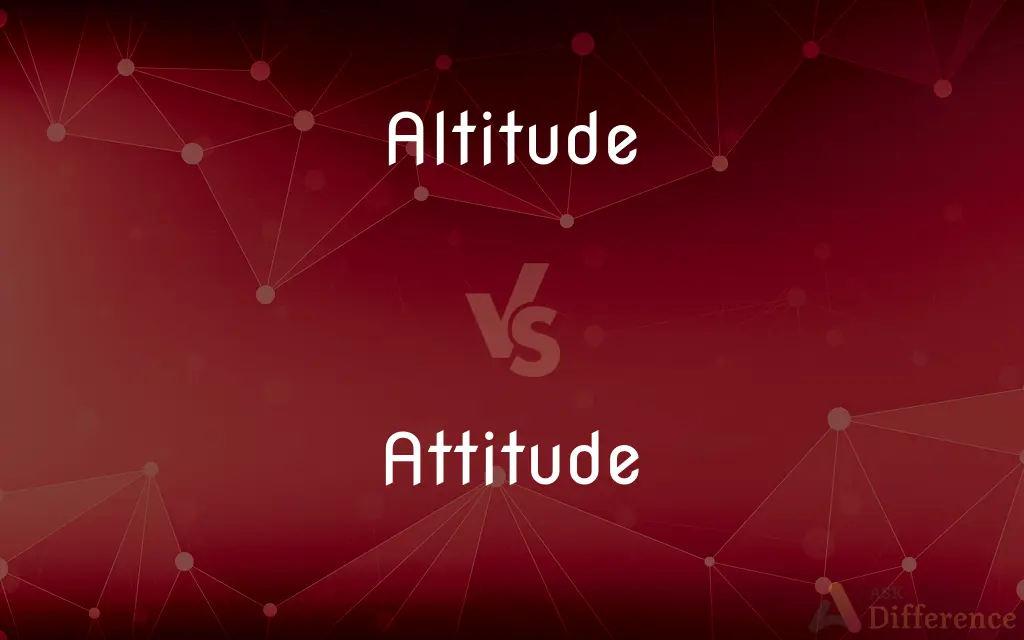Altitude vs. Attitude — What's the Difference?
By Fiza Rafique & Maham Liaqat — Updated on March 5, 2024
Altitude measures height above sea level, emphasizing geographic or flight-related contexts, while attitude denotes a person's outlook or mindset, crucial in psychology and social interactions.

Difference Between Altitude and Attitude
Table of Contents
ADVERTISEMENT
Key Differences
Altitude refers to the elevation of an object or point in relation to sea level or ground level, critical in aviation for safety and navigation. On the other hand, attitude describes an individual's perspective or feelings toward a situation, person, or object, influencing behavior and decision-making.
While altitude is quantifiable, measured in units such as feet or meters, indicating physical distance, attitude is qualitative, reflecting emotions, beliefs, and reactions that are subjective and vary from person to person.
Altitude has specific scientific applications, such as in geography for mapping terrains, and in meteorology for understanding weather patterns. Whereas, attitude is studied within psychology to understand human behavior, social interactions, and the impact of mindset on life outcomes.
Altitude adjustments are necessary for flight safety, efficiency, and to comply with regulations. Conversely, adjusting one's attitude can be pivotal in personal development, conflict resolution, and improving interpersonal relationships.
While altitude can be precisely measured using instruments like altimeters, attitude's measurement relies on psychological scales and self-reports, making it less tangible but equally important in different contexts.
ADVERTISEMENT
Comparison Chart
Definition
Height of an object or point relative to sea or ground level
A person's perspective or feelings towards a situation
Measurement
Quantitative (feet, meters)
Qualitative (surveys, observations)
Field of Study
Geography, Aviation
Psychology, Sociology
Importance
Essential for navigation and safety in aviation
Influences behavior and decision-making
Instruments/Methods
Altimeters, GPS
Surveys, Psychological tests
Compare with Definitions
Altitude
In geometry, altitude is a perpendicular distance from a vertex to the opposite side of a figure.
The altitude of this triangle is 5 cm.
Attitude
Psychological orientation.
An optimistic attitude helps in overcoming challenges.
Altitude
In aviation, it refers to aircraft height above ground or sea level.
The pilot adjusted the altitude to avoid turbulence.
Attitude
A predisposition to respond.
Their attitude towards the new policy was surprisingly open.
Altitude
Height above sea level.
The plane is flying at an altitude of 35,000 feet.
Attitude
Behavioral inclination.
His helpful attitude made him popular among his peers.
Altitude
Elevation on a mountain.
The base camp has an altitude of 17,500 feet.
Attitude
Emotional stance.
She displayed a negative attitude after the meeting.
Altitude
Atmospheric layers.
The ozone layer is found at a higher altitude in the Earth's atmosphere.
Attitude
Personal viewpoint.
His attitude towards work is very positive.
Altitude
Altitude or height (also sometimes known as depth) is a distance measurement, usually in the vertical or "up" direction, between a reference datum and a point or object. The exact definition and reference datum varies according to the context (e.g., aviation, geometry, geographical survey, sport, or atmospheric pressure).
Attitude
A settled way of thinking or feeling about something
He was questioned on his attitude to South Africa
Being competitive is an attitude of mind
Altitude
The height of a thing above a reference level, especially above sea level or above the earth's surface.
Attitude
Truculent or uncooperative behaviour
I asked the waiter for a clean fork and all I got was attitude
Altitude
Great height or elevation
Has trouble breathing at altitude.
Attitude
A manner of thinking, feeling, or behaving that reflects a state of mind or disposition
Has a positive attitude about work.
Kept a dignified attitude throughout the crisis.
Altitude
(Mathematics) The perpendicular distance from the base of a geometric figure to the opposite vertex, parallel side, or parallel surface.
Attitude
A position of the body or manner of carrying oneself
Stood in a graceful attitude.
Altitude
Height of degree; highest point or degree.
He is [proud] even to the altitude of his virtue.
Attitude
The posture, action, or disposition of a figure or a statue.
Altitude
Height of rank or excellence; superiority.
Attitude
A complex mental state involving beliefs and feelings and values and dispositions to act in certain ways;
He had the attitude that work was fun
Attitude
Position or arrangement of the body and its limbs;
He assumed an attitude of surrender
Common Curiosities
What is altitude?
Altitude is the height of an object or point relative to sea or ground level, measured in units like feet or meters.
Why is altitude important in aviation?
Altitude is crucial for safety, navigation, and adherence to flight regulations.
How do you assess someone's attitude?
Attitudes are assessed qualitatively, through surveys, observations, and psychological tests.
Is attitude innate or learned?
Attitude is considered to be a combination of innate predispositions and learned experiences.
What does attitude mean?
Attitude refers to a person's perspective, feelings, or stance toward a situation, person, or object.
Can altitude affect one's health?
Yes, high altitudes can affect health, leading to conditions like altitude sickness due to reduced oxygen levels.
Can attitude be measured directly?
Attitude cannot be measured directly; it is inferred from behavior, self-reports, and psychological tests.
How does attitude impact mental health?
Positive attitudes can improve mental health, while negative attitudes may worsen it.
How is altitude measured?
Altitude is measured quantitatively, often using instruments like altimeters and GPS.
How does attitude affect behavior?
Attitude influences an individual's decisions, behavior, and interactions with others.
What are the practical applications of studying altitude?
Applications include aviation safety, geographical mapping, and meteorological research.
What units are used to measure altitude?
Altitude is measured in feet, meters, or kilometers above sea level.
Are there any instruments to measure attitude?
While there are no physical instruments, psychological scales and surveys are used to assess attitudes.
How can attitude change?
Attitude can change through experiences, education, and personal reflection.
What role does altitude play in weather patterns?
Altitude influences weather patterns, including temperature, precipitation, and wind systems.
Share Your Discovery

Previous Comparison
Complete vs. Accomplish
Next Comparison
Wherein vs. WherebyAuthor Spotlight
Written by
Fiza RafiqueFiza Rafique is a skilled content writer at AskDifference.com, where she meticulously refines and enhances written pieces. Drawing from her vast editorial expertise, Fiza ensures clarity, accuracy, and precision in every article. Passionate about language, she continually seeks to elevate the quality of content for readers worldwide.
Co-written by
Maham Liaqat















































